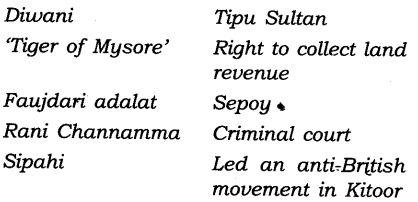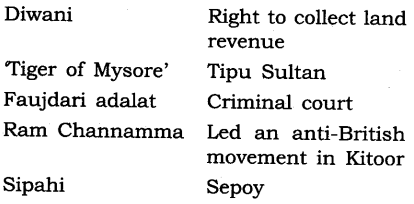EVENTS
CONVENT HIGH SCHOOL
23/08/2021 CLASS-8 SESSION2021-22(SLOT-1)
SOCIAL SCIENCE(HISTORY)
Chapter-2
FROM TRADE TO TERRITORY
_______________________________________
Question 1.Match the following:

Answer:
Question 2.Fill in the blanks:
(a) The British conquest of Bengal began with the Battle of …………
(b) Haider All and Tipu Sultan were the rulers of …………..
(c) Dalhousie implemented the Doctrine of ……………
(d) Maratha kingdoms were located mainly in the part of …………… India.
Answer:
(a) Plassey
(b) Mysore
(c) Lapse
(d) Western
Question 3.
State whether true or false:
(a) The Mughal empire became stronger in the eighteenth century.
(b) The English East India Company was the only European company that traded with India.
(c) Maharaja Ranjit Singh was the ruler of Punjab.
(d) The British did not introduce administrative changes in the territories they conquered.
Answer:
(a) False
(b) False
(c) True
(d) False
Question 4.
What attracted European trading companies to India?
Answer:
European trading companies were attracted due to the following reasons:
- Cheap and fine quality of silk and cotton.
- For spices like pepper, cloves, cardamom and cinnamon etc.
Question 5.
What were the areas of conflict between the Bengal Nawabs and the East India Company?
Answer:
- The Bengal nawabs asserted their power and autonomy and refused to grant the Company concessions,
- They demanded large tributes for the Company’s right to trade,
- They denied the Company any right to mint coins,
- They stopped the Company from extending its fortifications
- Accusing the Company of deceit, they claimed that the Company was depriving the Bengal government of huge amounts of revenue and undermining the authority of the nawab. It was refusing to pay taxes, writing disrespectful letters, and trying to humiliate the nawab and his officials. These were the areas of conflict between the Bengal Nawabs and the East India Company.
Question 6.
How did the assumption of Diwani benefit the East India Company?
Answer:
The Mughal emperor, in 1765, appointed the Company’s the Diwan of the provinces of Bengal. The Diwani allowed the Company to exploit the vast revenue resources of Bengal. This solved a major problem that the company had earlier faced. Although its trade had expanded, it had to buy most of the goods in India with gold and silver imported from Britain. The overflow of gold from Britain stopped after the assumption of Diwani. Now revenue from India could finance Company expenses. These revenues they used to purchase cotton and silk textiles in India, maintain Company troops and meet the cost of building the Company fort and offices at Calcutta.
Question 7.
Explain the system of ‘subsidiary alliance’.
Answer:
Subsidiary Alliance System
- The Britishers as a supreme power: Whichever state wanted to sign this treaty, had to accept the English as a supreme authority. The East India Company behaved as a guardian of that state.
- Appointment of resident: The state kept an English Resident in their court,
to check the activities of the king. - Keeping of an English army: Indian rulers were not allowed to have their army to protect the state from external and internal invasion. The state had to keep an English army. The state had to bear financial burden of the army.
- Giving to the territory: If the Indian rulers failed to make payments, part of their territories were taken away as penalty.
e.g.,- The Nawab of Awadh was forced to give over half of his territory to the company in 1801.
- Hyderabad was also forced to cede territories on similar grounds.
- Protection by the English: In return for the above-mentioned conditions the English Company promised to protect the state from its enemies. They also promised the state not to interfere in the internal affairs of the state but this was a promise they seldom kept.
Question 8.
In what way was the administration of the Company different from that of Indian rulers?
Answer:
The administration of the Company was different from that of the Indian rulers in the following ways:
- The Company divided its administrative units called Presidencies. There were three Presidencies – Bengal, Madras and Bombay. In India, districts were the main administrative units.
- Each presidency was ruled by a Governor. Districts were ruled by the Collectors.
- The supreme head of the administration of the Company was the Governor-General. But in India, the head of the administration was the king. .
- The main job of the Governor-General was to introduce administrative reforms while the main job of the Collector was to collect revenue and taxes- and maintain law and order in his district.
Question 9.
Describe the changes that occurred in the composition of the Company’s army.
Answer:
- East India Company adopted its own method when it began recruitment for the army.
- It was known as the sepoy army (from the Indian word sipahi, meaning soldier).
- With the change in warfare technology from the 1820s, the cavalry needs of the Company’s army declined, because the British empire was fighting in Burma, Afghanistan, and Egypt. There the soldiers were armed with muskets and matchlocks
- The soldiers had to keep pace with changing military requirements.
- Its infantry regiments now became more important.
- In the early 19th century the British began to develop a uniform military culture.
- Soldiers were given European-style training drills and discipline.
- They regulated their life far more than before.
- Often this created problems since caste and community feelings were ignored in building a force of professional soldiers.
Question 10.
After the British conquest of Bengal, Calcutta -grew from a small village to a big city. Find out about the culture, architecture, and the life of Europeans and Indians of the city during the colonial period.
Answer:
Hints: Visit the school library or get information from the internet.
Indians were influenced by British culture, architecture and lifestyle.
- Culture: British influence began.
- Architecture: Influenced by the British Architecture (fortification of the city, churches, etc.). Rich Indians started constructing bungalows in the English style.
- Life: English education, English clothes, became to be popular.

